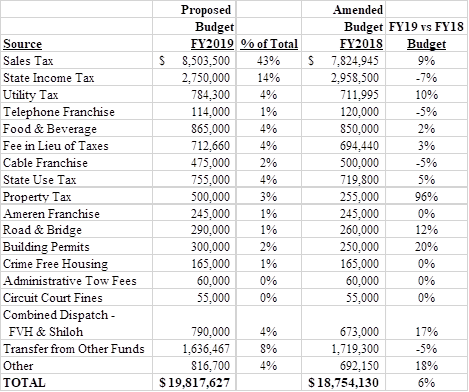2018/03/16 - Walter's Blog: Budget Revenue
I previously wrote about how our annual budget is structured. This time I will discuss our revenue situation. Local revenue sources are improving, and this budget does not contain any major cuts in programs or expenditures. 95% of residents believe O’Fallon is a great place to live and this budget will continue to provide high quality services to the community.
We are required by state law to have a balanced budget. Our total budget for FY2018-19 is $74,453,583, equally balanced by revenues. which means we have $74 million in revenues to equal $74 million in expenses. This represents a decrease of approximately 9% compared to the previous year. The reason for the decrease is due to the Destination O’Fallon capital projects 2017, which consisted of an expansion of the Family Sports Park.
Where possible, we have included the priorities listed in the City Council’s Strategic Plan to guide our budget decisions. This budget was programmed around the goals of the Mayor and City Council as expressed through direct input of the Mayor and Council, staff input, and refinement through City Council Committee review and the public hearing process. While the budget is based on the assumption that the same high levels and types of municipal service should be continued in all departments, the continued revenue instability will challenge our ability to provide services in the same manner as previous years.
The General Fund is the main fund for the City and it provides the budgets for Administration, Police, Community Development, Streets, Facilities, Police and Fire Commission, Economic Development, Cemetery, and IT departments. The General Fund revenue is estimated to increase approximately 6%, mainly due to increases in sales tax and diverting property tax revenue into the General Fund to pay for two new police officers.
The revenue for the General Fund is proposed to be derived as follows:

Sales tax comprises the largest part of the General Fund (43%). Sales tax revenues for FY2018-19 are 9% above the FY2017-18 budget. Sales tax revenues are due to an improving local economy and the addition of the Auffenburg Chrysler-Dodge dealership. Unfortunately, the Auffenburg St. Clair Auto Mall is moving to Shiloh in 2019 so those new revenues will be short-lived. This year’s proposed budget includes increased reserves to buffer the loss of $850,000 in sales tax when the Auto Mall moves to Shiloh.
We anticipate a 7% decrease in the State Income Tax revenue. The State Income Tax is appropriated to cities on a per capita basis from the state’s income tax revenue. Unfortunately, the state legislature reduced the cities’ share of the income tax by 20% as part of the state budget. The 20% is supposed to be a temporary one-year reduction, but Gov. Rauner recently proposed retaining the reduction one more year in his proposed budget.
Property tax comprises only 3% of the City’s budget and is ranked tenth among City General Fund revenue generators. While the total property tax levy was reduced this year, the percentage going to the General Fund increased 96% to pay for two new police officers. The property tax levy supports General Fund programs such as police, street maintenance and construction, and general administrative functions. Property taxes are also levied for Special Revenue Funds such as the Public Library, Parks and Recreation, Emergency Medical Services, Fire Department, and employee pension funds.
A new department was created for FY2017-18 to capture the costs for the combined 911 dispatch center for O’Fallon, Shiloh and Fairview Heights. This is a result of the state mandate to reduce the number of Public Safety Answering Points (PSAP). Shiloh was already part of O’Fallon’s PSAP service. Fairview Heights consolidated with O’Fallon beginning January 1, 2017.
Utility Tax revenues are estimated to increase 10% and are dependent on weather conditions. The Utility Tax is a tariff that is based on consumption and not the actual rate. Warm winters and cool summers can significantly affect Utility Tax. A large portion of the Utility Tax is committed to paying off the $7 million Public Safety Facility that was completed in 2004. The remainder is used to fund the Parks and Recreation Department. The Telecommunications Tax also is declining due to reduction of phone lines in homes.
The Food & Beverage tax is anticipated to increase due to the growth of eating establishments and the influx of visitors from the opening of St. Elizabeth’s Hospital and the Destination O’Fallon projects.
The “Fee in Lieu of Taxes” represents the portion of administrative salaries and benefits that were originally reflected in the Enterprise Funds (Water and Sewer). State law requires that municipal utilities charge an administrative fee, so they are similar to private sector utilities that must pay property taxes and utility taxes.
In summary, the City’s revenue situation is stable and growing, although we are concerned about the state government’s actions to reduce the City’s share of the state income tax. In my next blog, I will address our expenses in the annual budget and how it reflects the priorities identified by the City Council.

